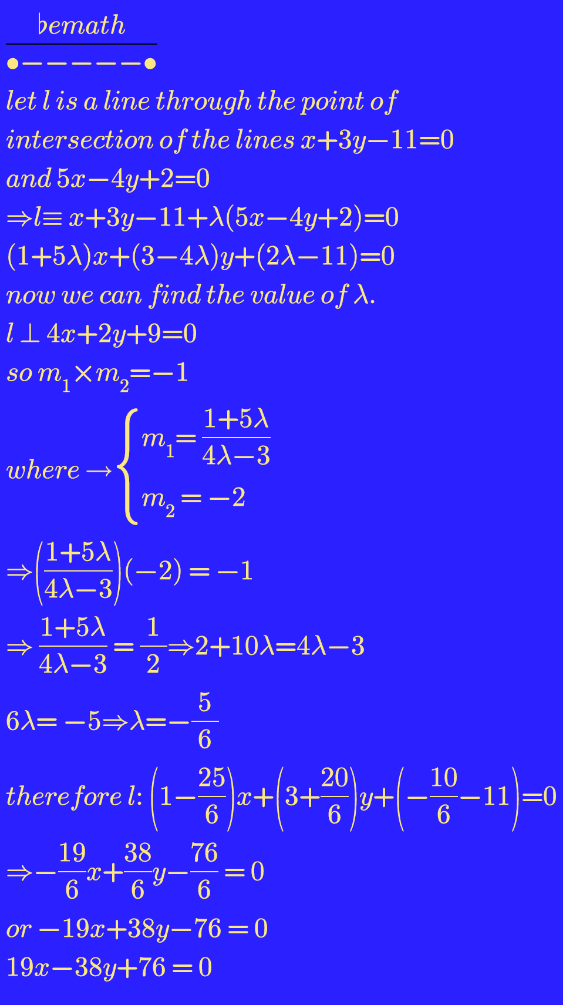Question Number 109160 by john santu last updated on 21/Aug/20

$${Find}\:{the}\:{equation}\:{of}\:{line}\:{through} \\ $$$${the}\:{point}\:{of}\:{intersection}\:{of}\:{the} \\ $$$${line}\:{x}+\mathrm{3}{y}−\mathrm{11}=\mathrm{0}\:{and}\:\mathrm{5}{x}−\mathrm{4}{y}+\mathrm{2}=\mathrm{0} \\ $$$${and}\:{perpendicular}\:{to}\:\mathrm{4}{x}+\mathrm{2}{y}+\mathrm{9}=\mathrm{0}. \\ $$
Answered by bemath last updated on 21/Aug/20

Answered by Dwaipayan Shikari last updated on 21/Aug/20

$$\mathrm{4}{x}+\mathrm{2}{y}+\mathrm{9}=\mathrm{0}\Rightarrow{y}=−\mathrm{2}{x}−\frac{\mathrm{9}}{\mathrm{2}} \\ $$$${slope}\left({m}\right)=−\mathrm{2} \\ $$$${mm}_{\mathrm{0}} =−\mathrm{1} \\ $$$${m}_{\mathrm{0}} =\frac{\mathrm{1}}{\mathrm{2}} \\ $$$${x}+\mathrm{3}{y}−\mathrm{11}+\Psi\left(\mathrm{5}{x}−\mathrm{4}{y}+\mathrm{2}\right)=\mathrm{0} \\ $$$$\left(\mathrm{1}+\mathrm{5}\Psi\right){x}+\left(\mathrm{3}−\mathrm{4}\Psi\right){y}+\mathrm{2}\Psi−\mathrm{11}=\mathrm{0} \\ $$$${y}=\frac{\mathrm{1}+\mathrm{5}\Psi}{\mathrm{4}\Psi−\mathrm{3}}{x}+\mathrm{11}−\mathrm{2}\Psi \\ $$$${m}_{\mathrm{0}} =\frac{\mathrm{1}+\mathrm{5}\Psi}{\mathrm{4}\Psi−\mathrm{3}}=\frac{\mathrm{1}}{\mathrm{2}}\Rightarrow\Psi=−\frac{\mathrm{5}}{\mathrm{6}} \\ $$$$\left(\mathrm{1}−\frac{\mathrm{25}}{\mathrm{6}}\right){x}+\left(\mathrm{3}+\frac{\mathrm{20}}{\mathrm{6}}\right){y}−\frac{\mathrm{5}}{\mathrm{3}}−\mathrm{11}=\mathrm{0} \\ $$$${x}−\mathrm{2}{y}+\mathrm{4}=\mathrm{0} \\ $$$${y}=\frac{{x}}{\mathrm{2}}+\mathrm{2} \\ $$
Answered by Aziztisffola last updated on 21/Aug/20

$${x}+\mathrm{3}{y}−\mathrm{11}=\mathrm{0}\Rightarrow{y}=\frac{\mathrm{11}−{x}}{\mathrm{3}} \\ $$$$\mathrm{5}{x}−\mathrm{4}{y}+\mathrm{2}=\mathrm{0}\Rightarrow{y}=\frac{\mathrm{5}{x}+\mathrm{2}}{\mathrm{4}} \\ $$$$\Rightarrow\frac{\mathrm{11}−{x}}{\mathrm{3}}=\frac{\mathrm{5}{x}+\mathrm{2}}{\mathrm{4}}\Rightarrow{x}=\mathrm{2}\:\Rightarrow{y}=\mathrm{3} \\ $$$$\left({x}+\mathrm{3}{y}−\mathrm{11}=\mathrm{0}\right)\cap\left(\mathrm{5}{x}−\mathrm{4}{y}+\mathrm{2}=\mathrm{0}\right)=\left(\mathrm{2};\mathrm{3}\right) \\ $$$$\mathrm{4}{x}+\mathrm{2}{y}+\mathrm{9}=\mathrm{0}\:\Rightarrow\overset{\rightarrow} {\mathrm{n}}\begin{pmatrix}{\mathrm{4}}\\{\mathrm{2}}\end{pmatrix}\:\mathrm{vector}\:\mathrm{normal} \\ $$$$\Rightarrow\mathrm{a}{x}+{by}+{c}=\mathrm{0} \\ $$$$\Rightarrow\mathrm{2}{x}−\mathrm{4}{y}+{c}=\mathrm{0} \\ $$$$\:\mathrm{2}×\mathrm{2}−\mathrm{4}×\mathrm{3}+\mathrm{c}=\mathrm{0}\Rightarrow\mathrm{c}=\mathrm{8} \\ $$$$\Rightarrow\:\mathrm{2}{x}−\mathrm{4}{y}+\mathrm{8}=\mathrm{0}. \\ $$$$\Rightarrow{x}−\mathrm{2}{y}+\mathrm{4}=\mathrm{0}. \\ $$
Answered by 1549442205PVT last updated on 22/Aug/20

$$\mathrm{Let}\:{the}\:{point}\:{of}\:{intersection}\:{of}\:{the} \\ $$$${line}\:{x}+\mathrm{3}{y}−\mathrm{11}=\mathrm{0}\:{and}\:\mathrm{5}{x}−\mathrm{4}{y}+\mathrm{2}=\mathrm{0} \\ $$$$\mathrm{denoted}\:\mathrm{by}\:\mathrm{A}.\mathrm{Then}\:\mathrm{the}\:\mathrm{coordintes} \\ $$$$\mathrm{of}\:\mathrm{A}\:\mathrm{are}\:\mathrm{root}\:\mathrm{of}\:\mathrm{the}\:\mathrm{system} \\ $$$$\begin{cases}{\mathrm{5x}−\mathrm{4y}+\mathrm{2}=\mathrm{0}}\\{\mathrm{x}+\mathrm{3y}−\mathrm{11}=\mathrm{0}}\end{cases}\Leftrightarrow\begin{cases}{\mathrm{5x}−\mathrm{4y}+\mathrm{2}=\mathrm{0}\:\left(\mathrm{1}\right)}\\{\mathrm{5x}+\mathrm{15y}−\mathrm{55}=\mathrm{0}\:\left(\mathrm{2}\right)}\end{cases} \\ $$$$\mathrm{Subtracting}\:\left(\mathrm{1}\right)\:\mathrm{from}\:\left(\mathrm{2}\right)\:\mathrm{we}\:\mathrm{get} \\ $$$$\mathrm{19y}−\mathrm{57}=\mathrm{0}\Rightarrow\mathrm{y}=\mathrm{3},\mathrm{x}=\mathrm{2}\Rightarrow\mathrm{A}\left(\mathrm{2};\mathrm{3}\right) \\ $$$$\mathrm{The}\:\mathrm{line}\:\mathrm{d}\:\mathrm{go}\:\mathrm{through}\:\mathrm{A}\:\mathrm{and}\:\mathrm{perpendicular} \\ $$$$\mathrm{to}\:\mathrm{the}\:\mathrm{line}\:\mathrm{4x}+\mathrm{2y}+\mathrm{9}=\mathrm{0}\:\mathrm{must}\:\mathrm{have} \\ $$$$\mathrm{the}\:\mathrm{direction}\:\mathrm{vector}\:\overset{\rightarrow} {\mathrm{p}}\://\overset{\rightarrow} {\mathrm{n}}\left(\mathrm{4};\mathrm{2}\right) \\ $$$$\Rightarrow\overset{\rightarrow} {\mathrm{p}}=\left(\mathrm{2};\mathrm{1}\right).\mathrm{Therefore}\:,\mathrm{the}\:\mathrm{equation}\:\mathrm{of} \\ $$$$\mathrm{d}\:\mathrm{is}:\frac{\mathrm{x}−\mathrm{2}}{\mathrm{2}}=\frac{\mathrm{y}−\mathrm{3}}{\mathrm{1}}\Leftrightarrow\mathrm{x}−\mathrm{2y}+\mathrm{4}=\mathrm{0} \\ $$$$\mathrm{Thus},\mathrm{the}\:\mathrm{line}\:\mathrm{we}\:\mathrm{need}\:\mathrm{find}\:\mathrm{has}\:\mathrm{the} \\ $$$$\mathrm{equation}\:\mathrm{is}\:\left(\boldsymbol{\mathrm{d}}\right):\boldsymbol{\mathrm{x}}−\mathrm{2}\boldsymbol{\mathrm{y}}+\mathrm{4}=\mathrm{0} \\ $$
Commented by peter frank last updated on 22/Aug/20

$$\mathrm{thank}\:\mathrm{you} \\ $$
